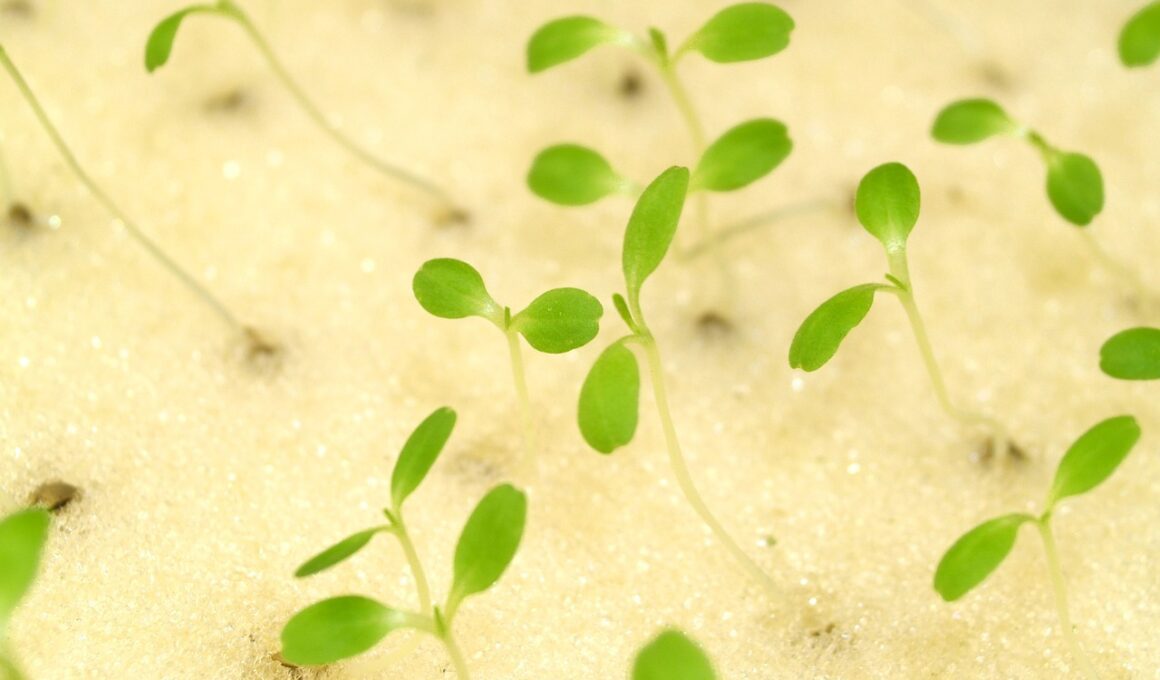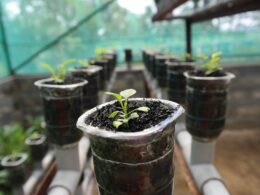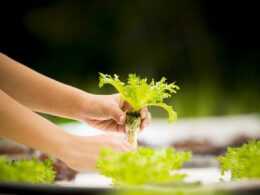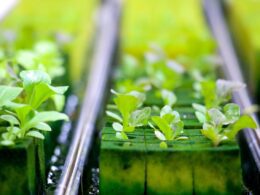Are you interested in hydroponic gardening but wondering how quickly your plants will grow? Hydroponic gardening is a method of growing plants without soil, using nutrient-rich water and a variety of growing mediums. The benefits of hydroponics include faster growth, higher yields, and the ability to grow plants year-round in any climate.
The growth rate of hydroponic plants can vary depending on several factors, such as the type of plants grown, the quality of the growing medium, and the nutrients provided. Understanding these factors can help you maximize the growth potential of your hydroponic garden and achieve faster, healthier plant growth.
In this article, we will explore the basics of hydroponic gardening, factors that affect the growth rate of hydroponic plants, and tips for improving growth rates.
Understanding the Basics of Hydroponic Gardening
One of the coolest things about hydroponic gardening is that it allows you to grow your own fresh produce in a unique and innovative way. Hydroponic gardening involves growing plants in a soil-free and water-based environment. Instead of using soil, hydroponic systems utilize nutrient-rich water solutions to supply plants with the necessary nutrients for growth.
There are various types of hydroponic systems, including deep water culture, nutrient film technique, and drip irrigation. One of the benefits of hydroponic gardening is that it allows plants to grow faster and produce higher yields compared to traditional soil-based gardening. Hydroponic systems provide plants with a constant supply of nutrients, which means they can grow at an accelerated rate.
In addition, hydroponic systems provide plants with optimal growing conditions, such as the perfect amount of sunlight and moisture, which can further enhance their growth. Moreover, hydroponic gardening is a more sustainable and environmentally friendly way to grow produce. Since hydroponic systems do not require soil, there is less soil erosion and depletion.
Additionally, hydroponic systems use less water compared to traditional soil-based gardening, making it a more water-efficient method. Overall, hydroponic gardening is a great way to grow fresh produce quickly and sustainably.
Factors that Affect the Growth Rate of Hydroponic Plants
If you want your hydroponic plants to grow as quickly as possible, you’ll need to pay attention to four key factors:
- Light
- Temperature
- Humidity
- Nutrient levels
The amount of light your plants receive will impact their growth rate, as will the temperature and humidity levels in your grow room. Additionally, you’ll need to ensure that your plants are receiving the right balance of nutrients to support healthy growth.
By optimizing these factors, you can help your hydroponic plants grow faster and produce a greater yield.
Light
Light’s crucial for optimal growth, so make sure your hydroponic system is equipped with proper lighting to achieve healthy and vibrant plants. When it comes to hydroponics, using the right type of light and controlling the intensity is key to ensuring your plants grow as quickly as possible.
Here are some important points to keep in mind when it comes to light in your hydroponic system:
-
Choose the right type of light: LED grow lights are a popular choice for hydroponic growers because they’re energy efficient and provide a spectrum of light that’s ideal for plant growth.
-
Adjust the light intensity: Too much light can damage your plants and slow down growth, while not enough light can lead to stunted growth. Make sure to adjust the intensity of your lights based on the specific needs of your plants.
-
Use timers: Consistent light cycles are important for healthy growth. Use timers to ensure your plants get the right amount of light each day.
-
Keep the lights close: Depending on the type of light you use, it’s important to keep them close to your plants to ensure they’re getting enough light. Be sure to follow the manufacturer’s recommendations for how far away your lights should be.
-
Monitor your plants: Pay attention to how your plants are responding to the light in your hydroponic system. If you notice any signs of stress or damage, adjust your lighting accordingly.
Temperature
Ensure that your hydroponic system maintains optimal temperature levels to provide the ideal conditions for healthy and vibrant growth. Hydroponic plants require a specific range of temperatures to grow at their best.
The optimal range for most hydroponic plants is between 65°F and 75°F (18°C to 24°C). If the temperature fluctuates too much outside of this range, it can significantly impact plant growth and development.
If the temperature in your hydroponic system is too high, it can cause your plants to wilt or even die. On the other hand, if the temperature is too low, it can slow down growth and make your plants more susceptible to diseases.
It’s important to monitor temperature levels regularly and make adjustments as needed. By ensuring that your hydroponic system stays within the optimal temperature range, you can create the perfect environment for your plants to thrive and grow quickly.
Remember that even small fluctuations can have a big impact on the health of your plants, so keep a close eye on the temperature in your system.
Humidity
Maintaining the right humidity level in your hydroponic system can be key to the success of your plants. High humidity can provide a number of benefits, including faster growth and increased yields. This is because high humidity levels can help plants absorb more nutrients and water, leading to stronger root systems and healthier overall growth.
It can also help prevent diseases and pests that thrive in drier environments. However, it’s important to not let humidity levels get too high, as this can lead to issues such as mold and mildew.
To control humidity levels in your hydroponic system, you can use a dehumidifier or air conditioner to lower humidity, or a humidifier to raise humidity. You can also adjust the amount of ventilation in your system to help regulate humidity levels.
By keeping a close eye on humidity levels and making adjustments as needed, you can create the perfect environment for your hydroponic plants to thrive.
Nutrient Levels
You’ll want to make sure your nutrient levels are balanced in order to provide your hydroponic plants with the essential elements they need to grow quickly and healthily.
The optimal pH for hydroponic plants is between 5.5 and 6.5, so it’s important to regularly test the pH of your nutrient solution and adjust it as needed.
In addition to pH, the composition of your nutrient solution is also crucial. Different plants require different levels of nitrogen, phosphorus, and potassium, as well as trace elements like calcium and magnesium.
Make sure to research the specific nutrient requirements for the plants you are growing, and adjust your nutrient solution accordingly.
By maintaining optimal nutrient levels, your hydroponic plants will thrive and grow quickly.
Comparing Growth Rates of Hydroponic and Soil-Grown Plants
Compare the growth rates of plants grown in soil versus those grown in a hydroponic system to see the differences in their development. Hydroponic plants usually grow faster than soil-grown plants because they receive a consistent supply of nutrients and water.
In hydroponic systems, plants are grown in a controlled environment with optimal growing conditions. This allows them to develop faster and produce higher yields than soil-grown plants.
Comparing yields of hydroponic and soil-grown plants is an important aspect of understanding the differences in their growth rates. Hydroponic plants can produce yields up to 30% higher than soil-grown plants. This is because hydroponic systems allow for precise control of water and nutrient levels, ensuring that plants receive the exact amount they need for optimal growth.
In contrast, soil-grown plants may not receive enough nutrients or water, leading to slower growth and lower yields. Nutritional value is another factor to consider when comparing the growth rates of hydroponic and soil-grown plants.
Hydroponic plants are often considered to be more nutritious than soil-grown plants because they receive a consistent supply of nutrients. This means that they can develop more vitamins, minerals, and antioxidants. Additionally, hydroponic systems can be designed to have fewer pests and diseases, reducing the need for pesticides and other chemicals that can affect the nutritional value of plants.
Tips for Maximizing the Growth Potential of Hydroponic Plants
If you want to maximize the growth potential of your hydroponic plants, there are a few key factors to consider. First, choose the right plants that are well-suited for hydroponic growing.
Next, provide adequate light to ensure that your plants can photosynthesize properly. It’s also important to maintain optimal temperature and humidity levels, as well as regularly monitor nutrient levels to ensure that your plants are getting everything they need to thrive.
Choosing the Right Plants
Picking the perfect crops for your hydroponic setup is crucial to ensure a successful and bountiful harvest. When it comes to plant selection, it’s important to consider the growth expectations of each crop.
Some plants like lettuce and herbs have a short growing cycle and can be harvested within a few weeks, while others like tomatoes and peppers have a longer growing cycle and may take several months to mature.
To make the most of your hydroponic setup, it’s also important to choose crops that are well-suited for hydroponic growing. Some plants, like strawberries and cucumbers, thrive in a hydroponic environment and can produce yields much higher than traditional soil-grown plants. On the other hand, some plants, like corn and wheat, may not be as well-suited for hydroponics and may not produce as high of a yield.
By carefully considering the growth expectations and suitability of each crop, you can ensure that your hydroponic garden is as productive as possible.
Providing Adequate Light
To ensure your plants thrive in your hydroponic setup, you need to make sure they bask in the warm glow of adequate light, as if they were soaking up the rays of a bright summer sun. Light spectrum and light intensity are key considerations for hydroponic plant growth. The spectrum of light your plants receive can affect the way they grow and produce. For example, blue light promotes vegetative growth, while red light is essential for flowering and fruiting. By providing a balance of both blue and red light, you can encourage your plants to grow strong and healthy.
In addition to light spectrum, light intensity is also important. Too little light can stunt growth, while too much light can damage or even kill your plants. It’s important to find the right balance for your specific plants and setup. A good way to measure light intensity is to use a lux meter, which measures the amount of light reaching a specific area. As a general rule of thumb, leafy greens and herbs need around 2,500-3,000 lux, while fruiting plants require closer to 7,000-10,000 lux. By providing your plants with the right spectrum and intensity of light, you can ensure they grow quickly and healthily in your hydroponic setup.
| Light Spectrum | Plant Response |
|---|---|
| Blue (400-500 nm) | Promotes vegetative growth |
| Green (500-600 nm) | Not essential for plant growth |
| Red (600-700 nm) | Essential for flowering and fruiting |
| Far Red (700-800 nm) | Can inhibit flowering and promote stem elongation |
Maintaining Optimal Temperature and Humidity
Now that you know how important light is for hydroponic plants to grow, let’s move on to another crucial aspect – temperature and humidity.
To achieve optimal growth, you need to maintain the right temperature and humidity levels inside your hydroponic garden.
First, let’s talk about temperature. Most hydroponic plants grow best between 70-75°F (21-24°C), but this can vary depending on the type of plant you’re growing. It’s essential to monitor the temperature regularly and adjust it accordingly. You can use a thermometer to check the temperature and a heater or air conditioner to regulate it.
Additionally, optimizing airflow can help maintain a consistent temperature and prevent the growth of harmful bacteria and fungus. On the other hand, if the temperature is too high, it can cause the plants to wilt, and if it’s too low, the plants may grow slower or even stop growing altogether.
Next, let’s focus on humidity. In general, hydroponic plants thrive in a humidity range of 40-60%. Again, this can vary depending on the plant’s specific needs.
High humidity can cause fungal growth and attract pests, while low humidity can lead to water loss and stunted growth. To maintain optimal humidity levels, you can use a humidifier or dehumidifier or simply adjust the airflow.
Additionally, preventing pests is crucial as they can damage or kill your plants. Regularly inspect your plants and use organic pest control measures, such as neem oil or insecticidal soap, to keep them healthy and thriving.
Monitoring Nutrient Levels
Monitoring the nutrient levels in your hydroponic garden is like being a scientist in a lab, carefully analyzing and adjusting the solution to give your plants the perfect balance of nutrients they need to thrive. The process is crucial to achieving optimal growth rates and yields.
Here are some important things to keep in mind when monitoring nutrient levels in your hydroponic garden:
- Maintaining the correct pH level is essential to ensure that the plants can absorb the nutrients properly. The ideal pH range for most plants is between 5.5 to 6.5.
- The Nutrient Film Technique (NFT) involves constantly flowing a thin film of nutrient solution over the roots of the plants. It is a highly efficient method of delivering nutrients to the plants and requires precise monitoring to avoid nutrient deficiencies or excesses.
- Electrical Conductivity (EC) measures the concentration of dissolved salts in the nutrient solution. It is essential to ensure that the level is within the correct range to avoid plant stress or damage.
- Monitoring the levels of macronutrients, such as nitrogen, phosphorus, and potassium, is crucial to ensure that the plants are growing at their maximum potential.
- Micronutrients, such as iron, zinc, and copper, are the trace elements that plants need in smaller quantities. Even though they are required in smaller quantities, they are just as important as macronutrients for the plant’s growth.
By carefully monitoring and adjusting the nutrient levels in your hydroponic garden, you can give your plants the perfect environment to grow and thrive. Remember to keep an eye on the pH balance, use the Nutrient Film Technique, measure the Electrical Conductivity, and ensure that the plants are receiving the right balance of macronutrients and micronutrients.
With these factors in mind, you can be confident that your hydroponic plants will grow quickly and produce a bountiful harvest.
Conclusion and Future Directions
You’ve learned about the impressive growth rate of hydroponic plants and how they have the potential to revolutionize the way we cultivate crops. With future advancements in technology, we can expect to see even faster growth rates and higher yields. However, there are also potential drawbacks to consider, such as the high initial cost of setting up a hydroponic system and the need for consistent monitoring and maintenance.
Despite these potential drawbacks, the future looks bright for hydroponic cultivation. As the world’s population continues to grow, we’ll need innovative solutions to feed everyone. Hydroponics offers a sustainable and efficient way to grow crops, using less water and space than traditional farming methods.
Additionally, advances in automation and artificial intelligence could make hydroponic systems even more efficient and cost-effective in the near future. In summary, hydroponic plants have a remarkably fast growth rate and offer a promising solution to our food production needs.
While there are potential drawbacks to consider, the future looks bright for this innovative method of cultivation. As we continue to explore new technologies and methods, we can expect to see even more impressive growth rates and yields in the years to come.
Frequently Asked Questions
What is the cost involved in setting up a hydroponic garden?
If you’re interested in setting up a hydroponic garden, it’s important to consider the initial investment and ongoing maintenance costs. The initial investment can range from a few hundred dollars for a small setup to several thousand for a larger one. This includes the cost of equipment such as grow lights, pumps, and nutrient solutions.
However, the maintenance cost is relatively low compared to traditional gardening as there’s no need for soil, pesticides, or herbicides. Additionally, hydroponic plants grow faster and produce higher yields, making it a cost-effective and sustainable option in the long run.
With proper care and attention, your hydroponic garden can thrive and provide fresh, healthy produce year-round.
Can hydroponic plants be grown without the use of artificial lighting?
Looking to grow hydroponic plants without the use of artificial lighting? You’re in luck!
Natural lighting can be used to grow hydroponic plants, though it may require some adjustments to the setup. Organic hydroponic gardening is a great way to grow plants without the use of artificial chemicals, and natural lighting is a key component of this method.
By utilizing natural light, you can create a more sustainable and eco-friendly garden while still enjoying delicious, healthy fruits and vegetables. With a little research and experimentation, you can find the perfect balance of natural light and other environmental factors to ensure your hydroponic garden thrives.
Are there any specific nutrients that hydroponic plants require?
To ensure your hydroponic plants grow strong and healthy, it’s important to understand their essential nutrient requirements and pH levels.
Hydroponic plants need a balanced mix of macronutrients (nitrogen, phosphorus, and potassium) and micronutrients (iron, calcium, magnesium, etc.) to thrive, which can be provided through nutrient solutions. However, common nutrient deficiencies can occur in hydroponic plants, such as nitrogen or iron deficiencies, which can stunt growth and impact yields.
Regularly monitoring and adjusting your nutrient solution, along with maintaining proper pH levels, is crucial for successful hydroponic plant growth. By understanding hydroponic plant nutrition, you can prevent nutrient deficiencies and ensure your plants reach their full potential.
How frequently should the water be changed in a hydroponic system?
To maintain a healthy hydroponic system, it’s important to change the water frequently. The frequency of water change depends on the size of the system and the type of plants grown. As a general rule, it’s recommended to change the water every two to three weeks. However, if you notice any signs of nutrient deficiencies or algae growth, you may need to change the water more frequently.
In addition to changing the water, it’s important to ensure that the nutrient solution formulation is balanced and provides all the necessary nutrients for your plants to grow. By maintaining the proper water change frequency and nutrient solution formulation, you can ensure that your hydroponic plants grow healthy and strong.
What are the advantages of using hydroponic gardening over traditional soil-based gardening?
If you’re considering hydroponic gardening, you’ll be pleased to know that there are many benefits to this method compared to traditional soil-based gardening.
One of the biggest advantages is that hydroponic plants grow faster and produce higher yields than their soil-grown counterparts.
Additionally, hydroponic gardening uses less water and requires fewer pesticides and herbicides, making it a more environmentally friendly option.
Another benefit is that hydroponic gardening allows you to grow plants year-round, regardless of the weather outside.
Overall, if you’re looking for a more efficient and sustainable way to grow plants, hydroponic gardening is definitely worth considering.
Conclusion
Congratulations on reaching the end of this article! By now, you should have a better understanding of how quickly hydroponic plants can grow and the various factors that can affect their growth rate.
Remember, the key to maximizing growth potential is to maintain optimal growing conditions, such as pH levels, nutrient concentration, and temperature.
If you’re new to hydroponic gardening, don’t be discouraged if your plants don’t grow as quickly as you expected. It takes time and patience to achieve the desired results, but with proper care and attention, your hydroponic plants can thrive.
Keep experimenting with different growing techniques and nutrient solutions to find what works best for your plants.
In the future, we can expect to see even more advancements in hydroponic technology and techniques, allowing for faster and more efficient plant growth. So keep exploring and pushing the boundaries of hydroponic gardening, and who knows what amazing results you may achieve!









